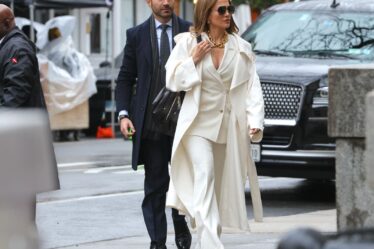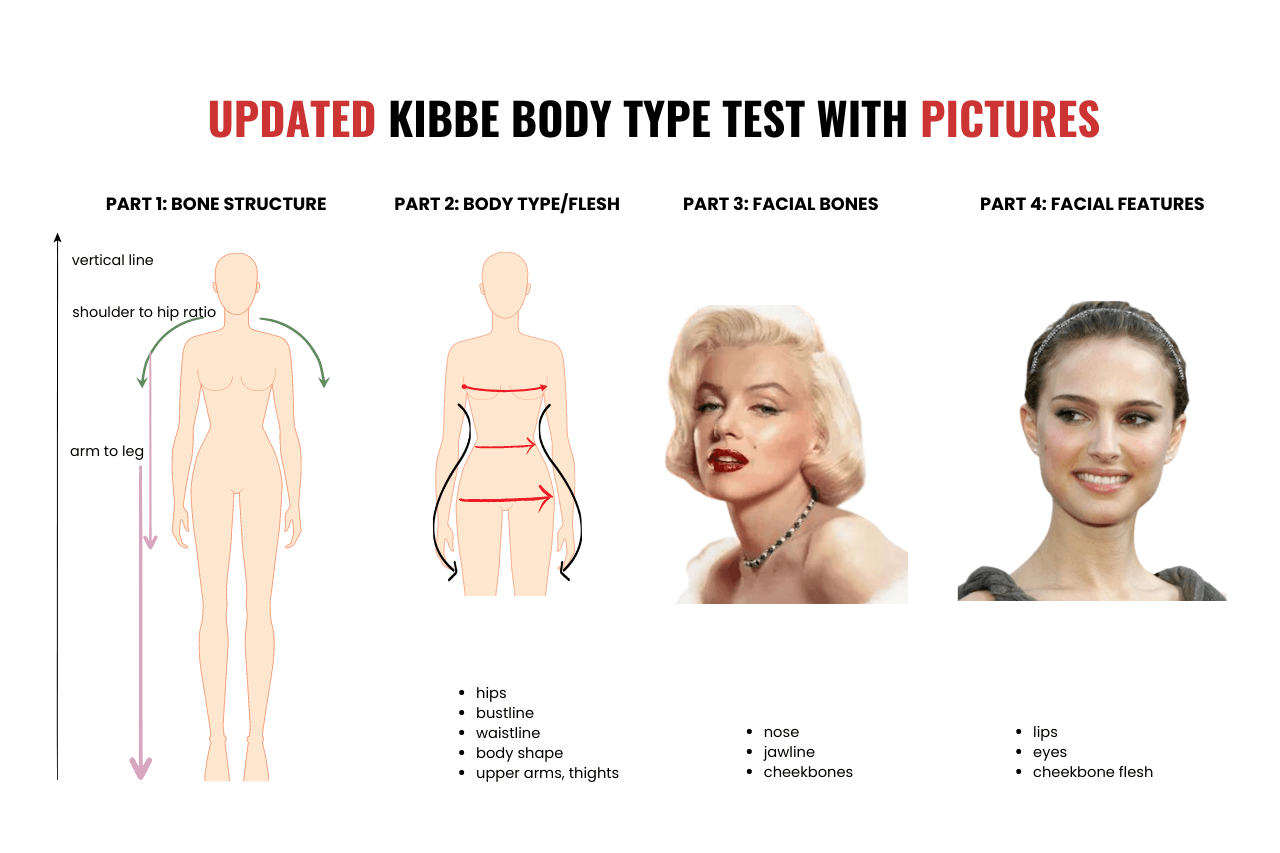
Learn how to style yourself like a Professional Fashion Stylist and get the Kibbe Style Guides & Clothing Recommendations right here!
David Kibbe created his ultimate body types guide way back in the 1980’s and the original version included facial features and bone structure in the Kibbe Body Types Test.
However, in the intervening years, Kibbe has tweaked and updated his guide to make it more accurate and more suited to contemporary women.
This version of the Kibbe Body Test follows Kibbe’s decision to exclude facial features from the test, as he ultimately felt they do not affect your body type.
And that also happens to make the HerStyleCode, updated Kibbe Body Test simpler and quicker. So if you want the easiest version of this super-helpful personal style guide – this is definitely it!
So make yourself a cup of coffee and prepare to change your whole approach to clothes shopping and figure flattering outfits!
Will my Kibbe body shape change?
No, so it makes sense to take your time to discover your individual style identity!
David Kibbe says your style identity doesn’t change when you put on or lose weight.
He also recommends that the minimum age to evaluate your body type is 25 years old. So if you’re aged 25 or more, now is the right time to do the updated Kibbe Body Types Test.
In my own fashion industry experience, I find that women’s body-type/style identity becomes more obvious through the years.
And having children never affects your individual body type. Nor does any gain or loss of weight – so if you do the Kibbe Body Test now it will help you look better for your whole life!
Kibbe Body Test with Pictures – Preparations
Photo No. 1 – Figure
1. First of all, take a full-length photo of yourself including the top of your head down to the tips of your toes.
2. Take the photo with the rear camera of your phone and make sure you’re wearing plain swimwear, or your bra and briefs.
3. Don’t change your natural shape by wearing a padded bra or a compression sports’ bra. It’s better to wear a light support, unlined bra that shows your natural shape.
4. The camera should be lined up to your chest height to avoid a distorted photo of your figure. Ensure it’s set at a 90º angle to the floor.
You can do this by placing some books on a table or chest-of-drawers to get the correct height, or with a small tripod – using the timer on your camera-phone.
5. If convenient, ask someone else to take the photo.
Photo No. 2 – Face
1. You’ll also require a straight-on image of your face taken with the rear camera.
- This is important as the average ‘selfie’ distorts your face.
- Place the phone in a location where you can use it exactly in line with your face for an accurate image
- Take two or three pictures to show neutral and smiling facial expressions
3. Please approach the test with an open mind about what your body type is, because if you think you already know, you may bring a bias to the answers that could give you a wrong result.
If you find it really hard to be objective, ask a trusted friend or family member to give you an accurate point of view.
4. You’ll need paper and pen to note down your answers, as this test needs precise answers.
5. Use the Kibbe Body Test with pictures to create a careful evaluation of your Kibbe body type. However, please don’t view it as a ‘straight-jacket’ with rules you must follow.
It’s a great basis for choosing figure-flattering clothes, but you are free to tweak the garment suggestions to suit your overall shape and personality!
How to take the best photo for the Kibbe Body Test with Pictures
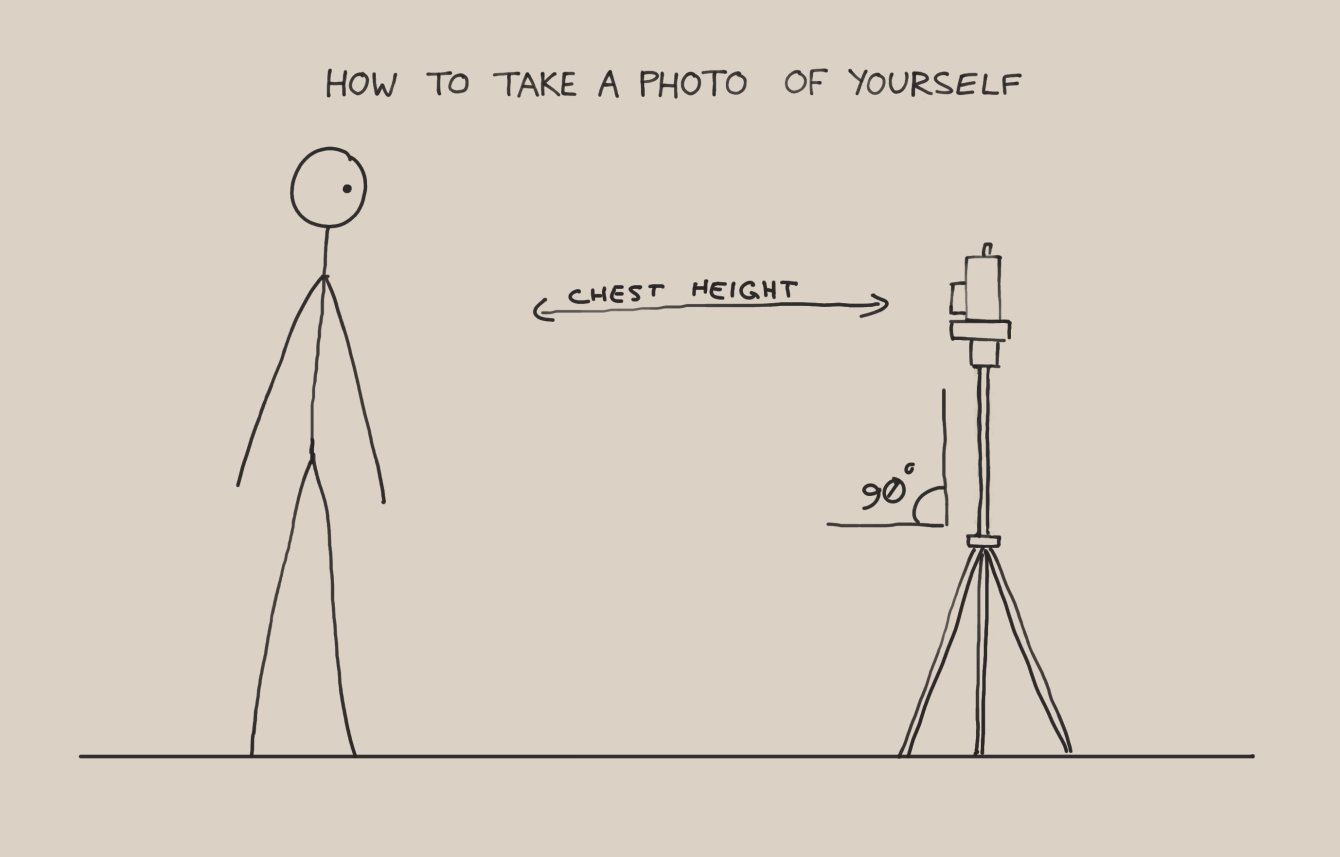
- Stand in a relaxed and natural way with your shoulders down and your head up
- Do not forget to include your full head and toes in the shot
- Remember to use the rear camera at a 90º angle to the floor
What’s included in the updated Kibbe Body Test with Pictures?
There are 2 main aspects of your body included in the updated Kibbe Body Test:
- Overall bone structure (or skeletal size)
- Body flesh distribution
How to record your Kibbe Body Test Answers
On a clean sheet of paper record the question number next to your answer letter after each section, like this:
Bone Structure
- C
- B
- C
If you follow this pattern, you can also write notes or doubts next to answers you struggled to decide and discuss them with a friend later.
HerStyleCode Kibbe Body Test Images
I’ve tried hard to get accurate example images to help you visually, but sometimes it has not been possible to get the same viewpoint angle for each and every one.
So I hope you will find the lines and annotations on pictures a useful aid to gauge the scale and differences between each answer!
Updated Kibbe Body Test with Pictures
Section 1 – Skeletal Bone Structure
This section deals with your overall frame and how it affects the way that clothes drape around your body.
It’s the most important section and looks at the shape, length and proportions of your bones.
1. What length is your vertical line?
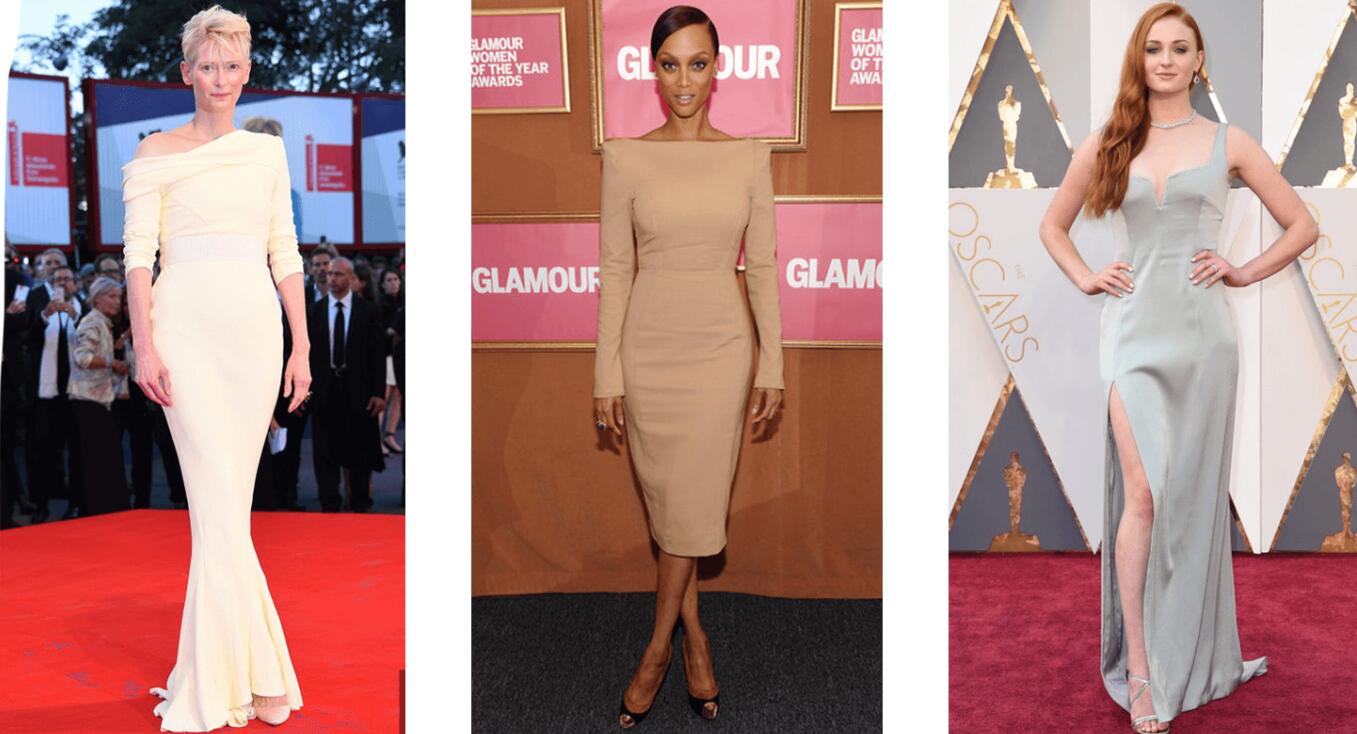
Tips to identify your Kibbe ‘Vertical Line’ accurately
Your ‘vertical line’ is usually defined as what height you appear to be to others. It’s not the same as your exact height, but how tall people perceive you to be – taking into account your horizontal lines or body ‘width’/‘narrowness’.
Think of two people you know who are the same height, but one of them seems taller, because there’s a difference in their skeletal structure. It could be that one person has wider shoulders, rib-cage or hips, which affect how they are perceived height-wise.
So when judging your own Vertical Line look at the area from your shoulders to your knees to get an accurate answer in accordance with the Kibbe Body Test.
Your Kibbe Vertical Line

A. Long – I appear to be taller than I actually am
B. Moderately long – I appear to be a little taller than I actually am, but not by much
C. Moderate – I appear to be my actual height
D. Smallish – I appear to be slightly shorter than my height
E. Petite – It’s quite clear that I am small in stature
2. Your Kibbe Shoulder Shape

Before you make a decision, ensure your stance is relaxed and you are not raising your shoulders.
A. Narrow/Sharp
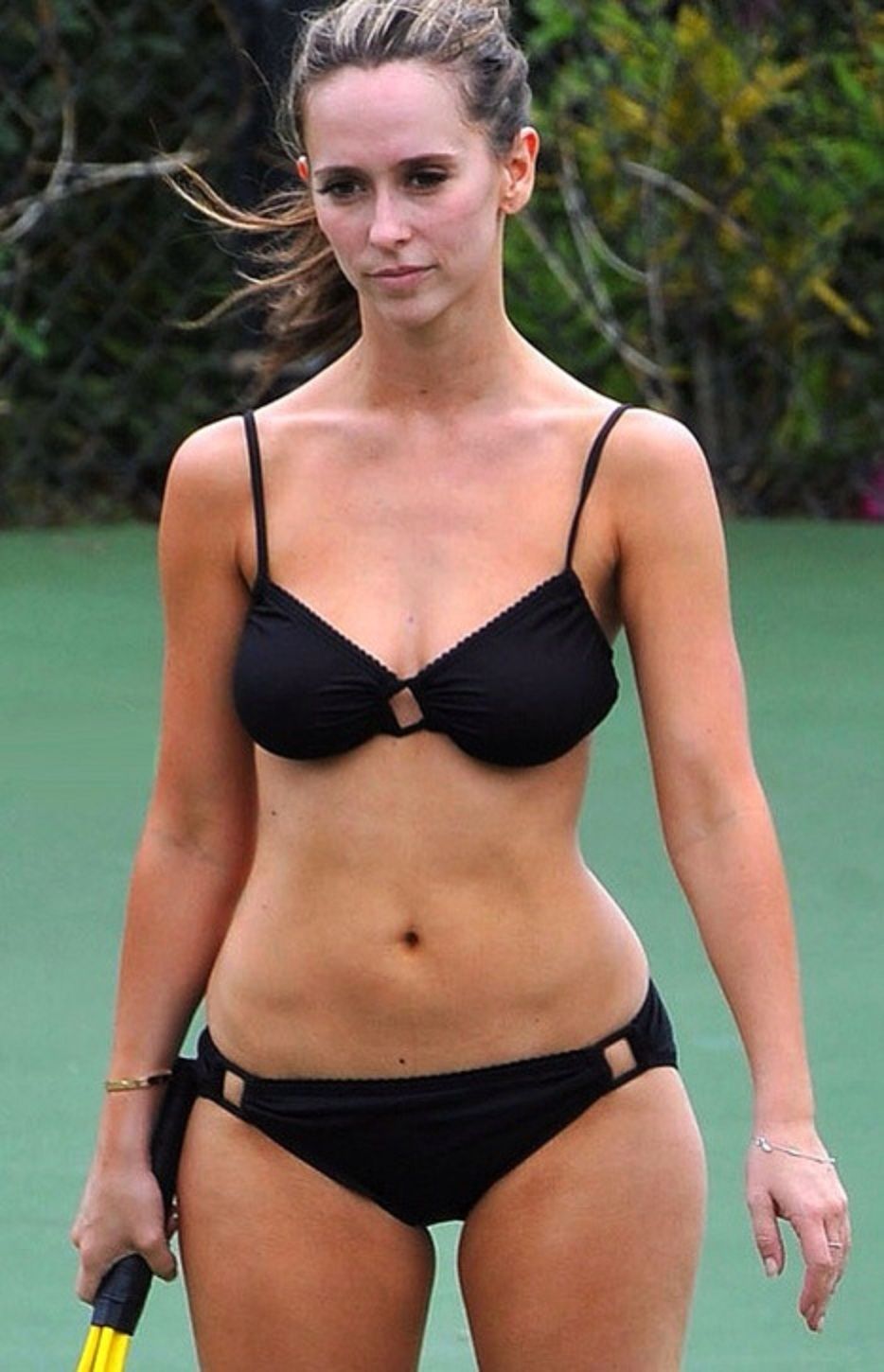
This example is sharp and angular, with no curves or blunt edges. They form a sharp, right-angle and this is obvious when right-angled lines are sketched over them.
However, although they are an angular shape, they still look narrow and delicate and there’s no obvious horizontal line on their shoulders.
B. Kibbe body type: Broad/blunt shoulder
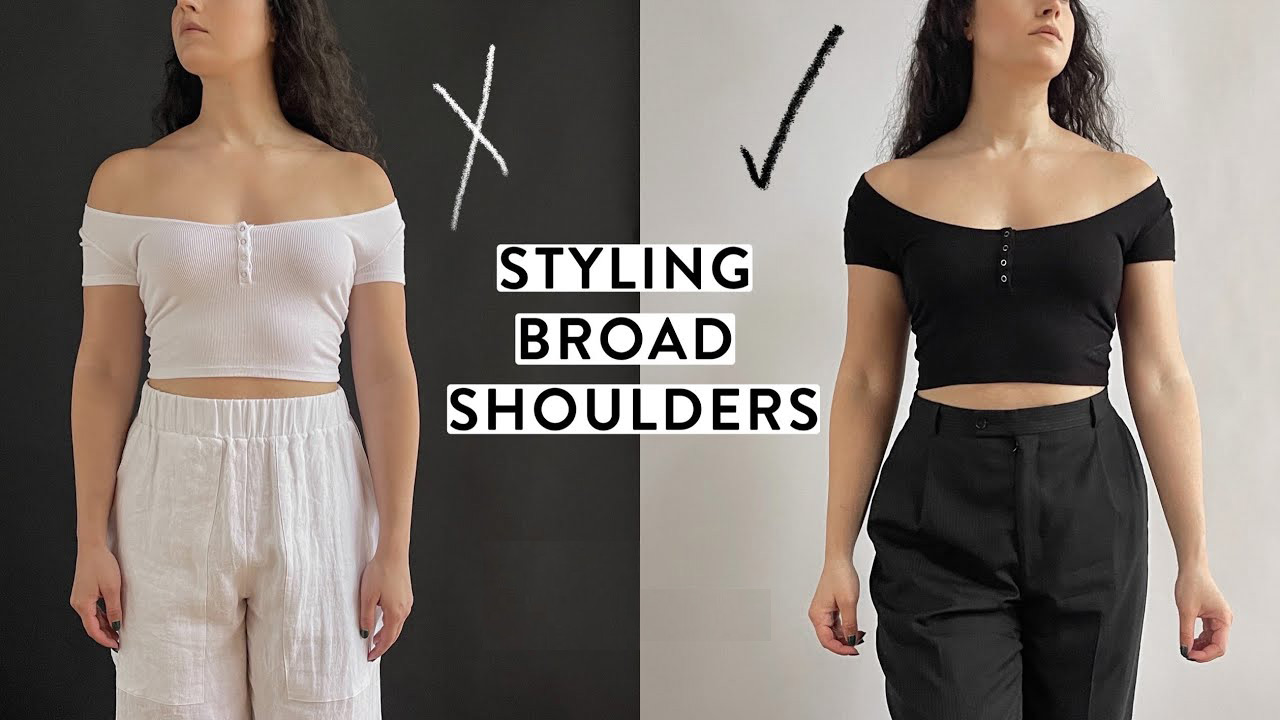
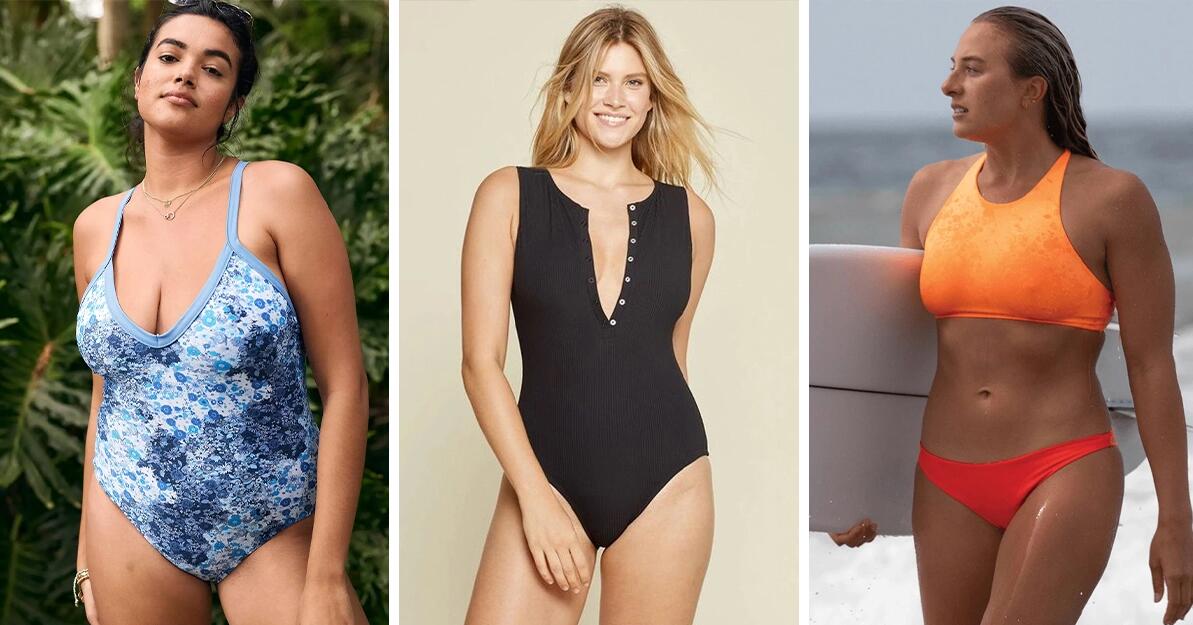
These examples show blunt and maybe broad shoulders clearly. They are quite noticeable, like sharp shoulders, but they usually have softer edges.
You can check the difference by comparing the right-angled lines from the shoulders in A) to those in B).
In B) the transition from shoulder to arms is clearly blunter. Angelina Jolie is a perfect example of this shoulder shape. And you should be able to see how prominent the horizontal lines are in these examples.
C. Kibbe body type: Even/moderate shoulder
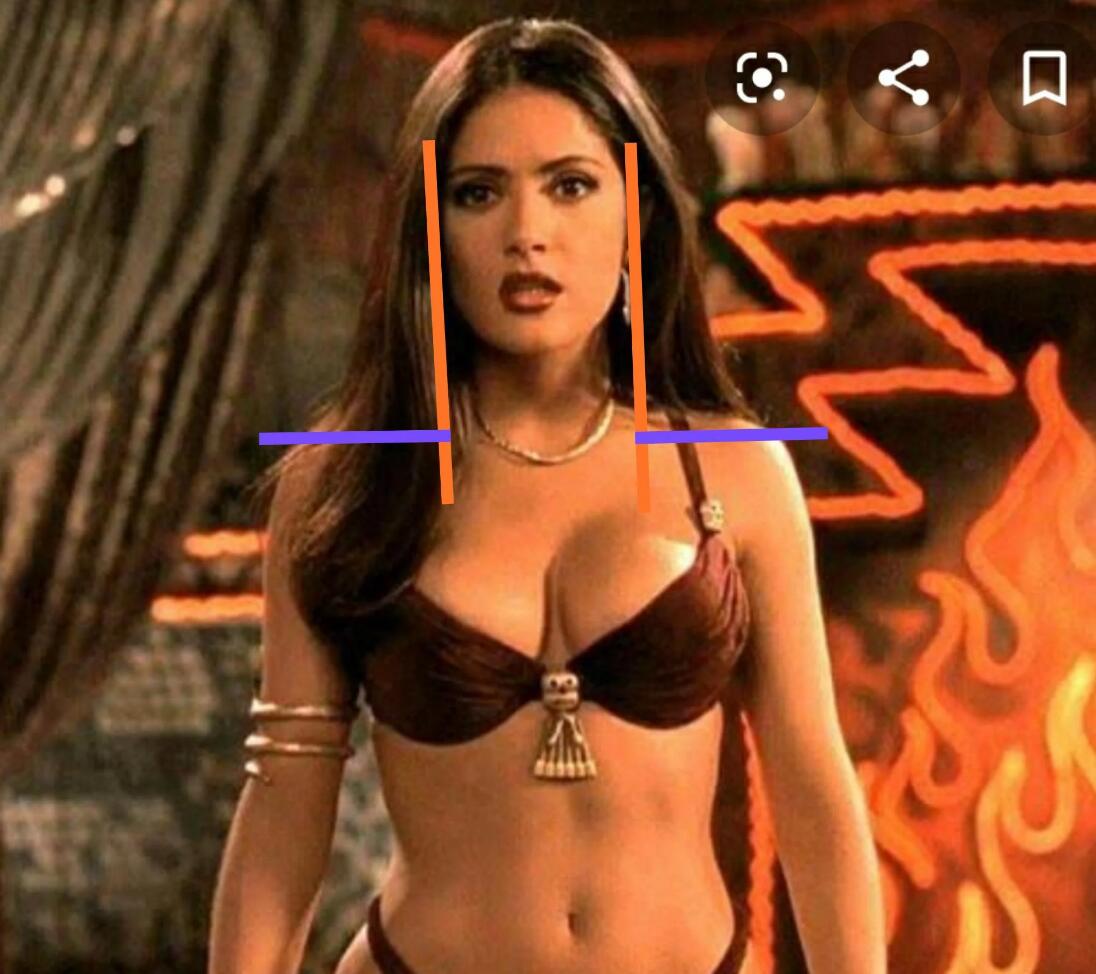
If you’re finding it difficult to decide your own shoulder shape, it may be because they are ‘even’ or moderate in form.
‘Even’ shoulders have a nice, symmetrical balance of Yin and Yang and no dominant characteristics.
D. Sloped/tapered shoulder

Sloped, but tapered shoulders tend to appear narrow.
E. Sloped/rounded shoulder
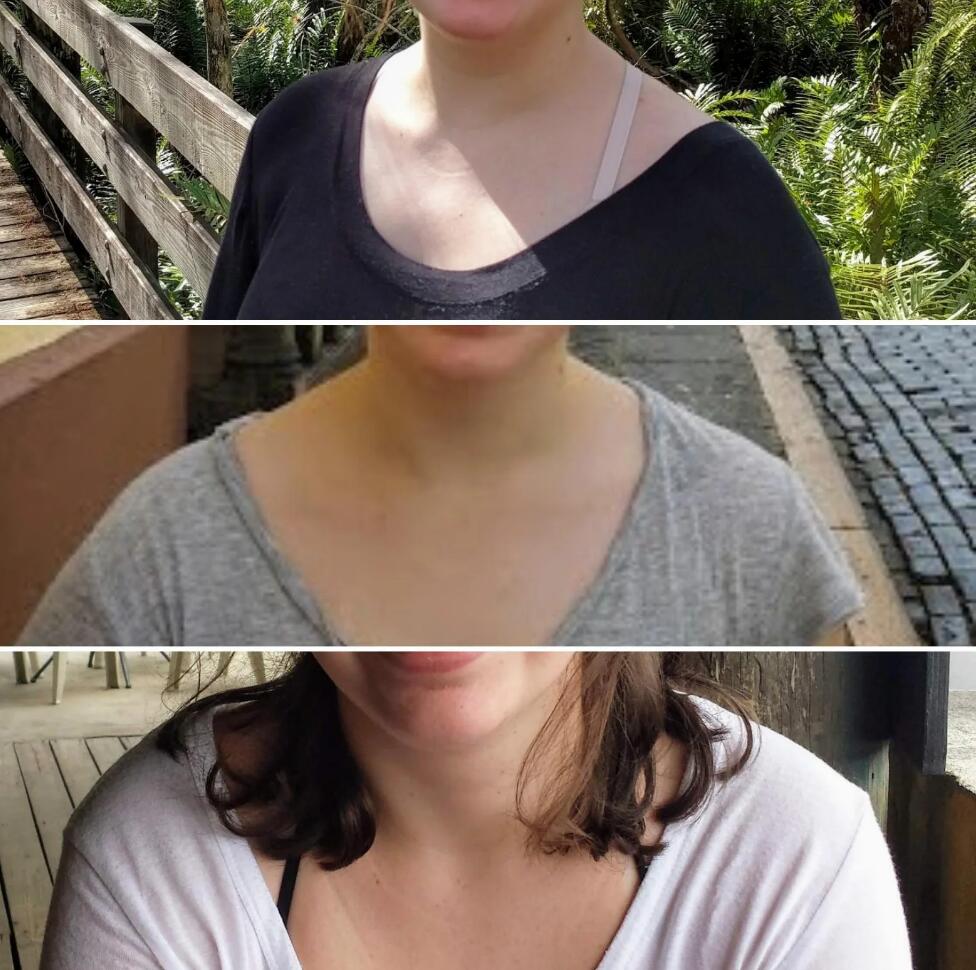
Sloped/rounded shoulders appear to be soft and round. Regardless of your weight, there will always be a curve in the shoulder transition and they are the opposite of A) Sharp/Narrow shoulders.
3. The Length and Shape of your Arms and Legs
When judging the length of your limbs, the best way is to see how they ‘measure up’ to the length of your body.
This means looking at their proportions in relation to your torso and you won’t need to actually measure your arms and legs with a tape-measure.
You may not have thought much about this before, but some short people have relatively long arms and legs and some tall people have proportionally short limbs.
You’ll get the best results if you use the photo you took of yourself at chest level and take note of where your fingertips end on your thighs, and in relation to your knees.
A. Elongated/narrow
Your limbs are narrow and long, with delicate looking or thin ankles, wrists and elbows. Your fingertips will come more than halfway down your thighs.
B. Elongated/broad
Your limbs are quite long, but they are broader in appearance and you do not have thin or dainty wrists, ankles and joints in general. However, your fingertips will reach roughly halfway down along your thighs.
C. Moderate limbs/evenly proportioned
You have well-proportioned limbs in relation to your body and your fingertips reach halfway down your thighs. Your body doesn’t appear to be either dainty or broad.
D. Small/short
Your arms and/or legs are a little short in proportion to your torso and your fingertips do not reach the halfway point down your thighs.
Your arms and legs are slightly shorter compared to your full body. Your legs don’t appear long, especially when you’re wearing flat shoes.
E. Small, very short proportionally to height and torso
You appear to be short – even if you aren’t particularly short in height. This is because your arms and legs aren’t completely in proportion with your body.
Your fingertips reach a point above the halfway point of your thighs and may be close to the bottom of your rear.
4. Kibbe Body Test with Pictures – Size & Shape of Your Hands & Feet
A. Long & narrow
Your palms and fingers are both long and they will be larger when compared with the length of your face.
B. Large & broad
Your hands are also large when compared with your face, but they are wider than hands in A) above.
C. Moderate – not small or large
Your hands look well-proportioned in comparison with your face and they are usually recognized as obviously not small, nor large.
D. Small/narrow/delicate
Your hands are dainty and delicate with more length than width. They are also small-looking when compared to your face.
E. Small & slightly wide
Compared to the face your hands are small, but they are wider than those shown in D). Because of their width, they don’t look or feel dainty.
If you find it tricky to decide if your hands fit this description take a photo of your hand next to your face to get a clear view.
Hand Evaluation Tips:
Use the rear-facing camera and ensure your lens is in a straight line with your face and not tilted up or down.
If you’re struggling to decide if your hands are broad or not, try looking at how far the bones at the base of your hand
And if you’re wondering how to tell if your hands are broad, it can help to look at the outer bones on the base of your hands and not how far they stick out from your wrist and fingers.
The example above shows broad hands.
Section 2: Body Flesh Distribution
This section of the Kibbe Body Test deals with the way your flesh lies on your body. This isn’t by any means a discussion of your weight or how much fat you carry.
It’s just an objective look at how your skin appears as it covers your bones and muscles.
For example, model Gigi Hadid is a very thin person, but she still has a round face and full cheeks. And it is quite possible for a person to be heavy and curvy, but still have sharp Yang cheekbones.
So this section will compare your bust, waist and hip flesh to decide if they are Yin – soft and rounded or Yang – sharp and angular.
5. Defining Your Overall Body Shape for the Kibbe Test with Pictures
Use the black lines as a comparison aid when you compare your shoulders, waist and hips.
A. Long & Lean
This body shape has a straight waist and no noticeably defined curves. Your hips are narrow and your chest is usually small or average.
Although there is not a lot of shape definition to the shape, it still looks ‘narrow’.
B. Broad & Muscular Looking
The noticeable characteristic of this body type is ‘broadness’. The shoulders, bust, waist and hips aren’t clearly defined.
When overweight, this body type will look blocky and rectangular.
C. Moderate & Well-Proportioned
This is a symmetrical body shape with subtle curves and definition. There is a definite waist, but nothing like an hourglass waist. And the shoulders and hips are usually of similar width.
This is a body shape that isn’t ‘curvy’ or ‘straight’, but a balanced in-between type.
D. Shapely, Soft Hourglass – Not Over-Defined
Your body type has a defined waist, without an all-over voluptuous vibe. This shape is made up of a noticeable Yin waist, with a rounded bust and hips. However, the angular shoulders add a dash of Yang.
When this body type gains weight, they look curvier with a frame that tends to look like an hourglass. However, you don’t have sufficient extra flesh on the bust and hips to qualify as sensuous.
E. Clearly Defined Hourglass Shape with Rounded Edges
This body shape has a clearly visible hourglass shape and all of the characteristics are rounded. You have a well-defined waist along with a full bust and hips that all add rounded edges.
Even if you are quite slender, you still have rounded edges and lack any angles on your shoulders or hips. This is sometimes called a ‘lush’ or ‘sensuous’ shape.
6. Kibbe Body Test with Pictures – Shape of Bust & Upper Torso
When judging the overall shape of your upper torso and chest, you will need to consider the flesh around your upper back and sides. Consider what shape outline it creates.
Forget your cup size, as this is not relevant here and shouldn’t be counted as a significant trait. Women with a large bosom are not automatically ‘Yin’.
A. Flat, taut & small
On the other hand, any weight gain or loss could affect your bust, so try to read the descriptions closely to ensure you get the most accurate answer for your body.
If your bust stays the same size, even when you put on weight, and are quite flat with little breast definition you should answer A) because you’re measuring bust-line and not the size of your chest.
B. Wide & broad, but small
This bust-line is flat and small in size. It equates to answer A), but there’s more width in the torso. You never manage to get a cleavage, even after putting on weight.
C. Moderate/Even
This bust-line is between full and flat and if you gain weight it often goes on here. The breast-shape is round and defined, but doesn’t create any cleavage.
D. Curved & Round-Shaped/Full
Your bust-line is prominent and rounded, with some cleavage at the top. If you gain any weight, your chest will increase in size. You are still considered moderate in your bust size, and your bust is more prominent than your waist-line.
E. Prominent/Busty
You have a prominent bust-line whether you are slender or weighty, with a noticeable cleavage line and shape. Your bust is definitely large and requires strong support. You cannot go braless.
7. Kibbe Body Test with Pictures – Waistline Shape
A. Elongated, “boyishly-tapered” and weight gain doesn’t affect this.
Your waist is long and straight, but your shape never appears broad. You have a ‘boyish’ shape as your waist isn’t sharply defined between your bust and hips. And if you gain weight, you don’t gain any more curves.
B. Elongated & broad
This waistline seems long compared to the rest of your figure, but it’s not sharply defined. Instead of being, tapered to a ‘boyish’ shape, this waistline is broad and less defined than answer A).
C. Moderate, slightly defined
If you just can’t seem to decide what shape of waistline you have, you are probably a ‘moderate’. You will have some waist definition, which is well proportioned with your shoulders, bust and hips, but it isn’t particularly defined, elongated or straight. Look for a gentle inward slope at your waist.
D. Very small compared to your shoulders, waist and hips
This waist shape is clearly defined with sharper edges that point inwards and highlight the small size of the waist in relation to your bust and hips.
There is nothing particularly ‘round’ about your waistline.
E. Slightly defined, with a round quality but broad
This waistline is softly defined without any sharp Yang angles. The rounder edges make it a little wider than answer D).
8. Overall hip shape
Always view your hip shape in relation to the rest of your body.
A. Straight, narrow & tapered
Your hips are narrow and lack definition. And if you gain weight, it may appear on your hips, but they won’t gain shape or look more defined.
B. Fairly straight, slightly wide & slightly inwardly tapered
Your hipline is not defined, but is straight and broad. Any extra weight usually shows up here.
C. Moderate in comparison to bust and hips
You have balanced and moderate hips in relation to your waist and bust-line. This shape is sometimes hard to identify purely because it is so moderate. But some, ‘moderates’ have discernable hip dips.
D. Rounded & shapely – more pronounced than waistline
Whether you’re slim or large, your hips are always well-shaped, with soft edges and can look large in relation to your waist-line.
E. Extremely soft & rounded
Your noticeably rounded hips are soft and fleshy whether you gain or lost lbs. And this shape creates a soft, ‘S’ shape from your waist to your hip-line.
9. Kibbe Body Test with Pictures – Describe the flesh on your thighs & upper arms
You need to check whether you have taut or fleshy upper arms and thighs. So you can do this by pinching the flesh to see if it is tight or looser.
If you work out regularly, you probably have toned arms, which would be answer C).
If you’re overweight, you need to check if the amount of flesh on these two areas tends to be lean, considering what you weigh. And if it is, that would likely be answer A) or B).
On the other hand, if you are quite thin, but your arms and thighs are soft and fleshy, choose D) or E).
And if you simply can’t decide – you’re probably a ‘moderate’ C)!
A. Long, slender & lean for your weight
If you’re thin, there won’t be any flesh to pinch and if you’re larger, you will have some flesh to pinch – but not much compared to your overall weight.
B. Elongated & muscular looking
Not much flesh to pinch at all.
C. Moderate & balanced
Your flesh distribution is evenly balanced and moderate. You may find you can pinch some flesh on your arms or thighs, but not a lot and it feels neither fleshy nor lean for your body size.
D. Soft, with some definition & slightly shorter in proportion:
You have some softness and fleshy texture, but your arms will show some shape and definition.
E. Noticeably soft, slightly wide & fleshy
Your thighs and upper arms feel soft and fleshy. This can make them look wider and you can pinch a decent amount of flesh, whatever you weigh.
Updated Kibbe Body Test Answers Guide
To get an accurate idea of your test outcomes, look at each section and see which ‘letter’ dominates your answers.
This is because it’s quite possible for anyone to have a few answers that don’t fit a trend perfectly – but to have enough of an overall pattern to identify your Kibbe Body Type.
And you should also take the time to examine the charts to discover where your Kibbe Body Identity fits with Yin/Yang balance and ‘contrast’.
Mostly A) Answers = Dramatic
1. If the majority of your answers were A) for all sections, then you are a full Dramatic body type known as (D).
This body type is long, lean and angular with dominant Yang traits.
2. If you have mostly A) answers plus a small number of E) and/or D) answers, you qualify as a Soft Dramatic or (SD). Your E) and D) answers probably refer to your flesh.
3. Your body has a combination of dominant Yang angles, along with some Yin fleshy softness covering your bone structure.
Soft Dramatic Style Guide
Mostly B) Answers = Natural
1. If you have plenty of B) answers in all sections, then you are a Kibbe Natural (N). Your skeletal structure and flesh are elongated, blunt and broad in relation to each other.
And your body shows a Yang dominance that isn’t as strong and angular as the Dramatic Kibbe Body Type.
2. If you also have some A) answers in there with the B’s, you would be identified as a Kibbe Flamboyant Natural (FN) body type.
That means your skeletal structure is lean and long, but your flesh has a broad look as it covers your bones.
Flamboyant Natural Style Guide
3. If you have mostly B) answers, with some D or E answers, then you should identify as a Soft Natural (SN) body type.
Your frame will be a broad, slightly blunt, but elongated shape. However, your flesh has a soft, Yin tendency that softens your silhouette.
- Mainly C) Answers = Classic
Take a look at the Soft Natural Style Guide here!
1. If you have mainly C) answers in all sections then you have a completely Classic body type (C).
Your body traits are well-balanced and ‘blended’.
2. If you have scored mostly C) in the body flesh questions, with a few A) or B) answers for your bone structure, they your Kibbe body type is Dramatic Classic (DC).
You have a well-proportioned, even distribution of flesh, but your bone structure has some dominant Yang traits.
Dramatic Classic Style Guide
3. If you have a majority of C) answers for the skeletal structure section, along with a few D) or E) answers for body flesh, then your Kibbe body type is Soft Classic (SC).
Your skeletal structure is well balanced and in proportion, along with some soft, Yin traits in your flesh.
Soft Classic Style Guide
Mostly D) or E) Answers = Romantic
1. If you have mostly E) answers then your Kibbe body type is completely Romantic (R).
Your body frame and flesh have a preponderance of Yin traits, like rounded edges and softness. This is known as ‘lush Yin’ or ‘sensuous Yin’.
2. If you have mostly D) answers, your body type is Theatrical Romantic (TR). Your skeletal structure and flesh tend to be mostly Yin, but not as much as the pure Romantic.
3. You’ll also be a TR if you have mostly E) or D) answers, with just a few A) answers. You’re A) answers will mainly be in your bone structure, and your flesh and shape will display your softness.
Mixture of A/B answers & D/E answers = Gamine
If you have a fairly even set of opposite answers A/B and D/E that would mean your Kibbe body type is Gamine (G).
Gamine is a Yin/Yang combination that shows up in your differing bone structure and flesh.
2. If you find you have a mixture of A/B and D/E answers, but leaning more towards the A) and B) traits, that would make you a Flamboyant Gamine (FG).
Your individual features are in distinct Yin or Yang sectors and not blended. However, overall you do have some angular sharpness to your body shape.
Your toned body shows an angular silhouette, and whatever weight you happen to be, your body is never curvy.
3. If you get a good mix of answers, with perhaps more D/E than A/B, then your Kibbe body type is Soft Gamine (SG).
You are a special mix of Yin and Yang who may have a little roundness in your face. If you gain weight you become more rounded and working-out won’t give you highly-defined musculature.
Do you have questions about what your Kibbe Style Identity is and how to use that information to your benefit?
Go here for detailed style recommendations:
- Kibbe Soft Classic Style Guide
- Kibbe Body Types Clothing Recommendations
- Kibbe Flamboyant Natural Style Guide
- Kibbe Dramatic Classic Style Guide
- Kibbe Soft Natural Ultimate Style Guide
- Kibbe Soft Dramatic Style Guide
- Kibbe Weight Gain Patterns – Plus-Size Examples
How understanding your Kibbe Style Identity benefits your life
The Kibbe body type/style identity system shows us all how to dress in clothing that works with your body shape and flatters your natural shape.
It teaches you the skills learned by professional fashion stylists and lets you find the clothing that flatters your individual shape.
It has the potential to save you a huge amount of cash, as most of us only wear a small percentage of our wardrobe – the favorites that we can see flatter our shape the most!
By refining your understanding of what clothes suit your body and personality, you’ll avoid wasting money on piles of clothes you bought because they were ‘in fashion’, but don’t suit you!
Kibbe believes most women can wear any and all contemporary fashions if they choose to do so – you just need to know how to tweak the look and what parts to highlight!
And if constantly changing fashions don’t interest you, our updated Kibbe Style Guides will show you which clothing styles will give you an attractive look and long-lasting, sustainable wear!
So what do you think of the Kibbe Body Test? It isn’t meant to be perfect, so please don’t get obsessed if you feel undecided about a few answers.
Trusted friends and family can always be called upon to give you some help!
I have to say that the test has made a lot of difference to my shopping habits, and made it far easier to find what I need from shops full of different fashions.
For example, I now realize that I will never look my best in wide-legged jeans and so I can stop agonizing over which style to buy!
I can also walk past whole rails of full-length summer dresses, knowing they don’t suit my body type.
And I now buy fewer, better-quality garments that I know I will always look good in and wear frequently.
You may not have had time to do the whole Kibbe Body Test yet – it does need to be approached with patience – but what do you think of the idea of educating yourself about your body type and flattering styles?
It’s certainly going to help us all avoid wasting money on tempting fashion novelties that we soon push to the back of our wardrobe!
1. Did you find the test helpful in pointing you towards styles and particular garments to flatter your shape?
2. Did you get the result you expected or did you feel surprised at your final results?
3. Will you be changing your style as a result of taking the test?
4. How do you feel the test has benefited you personally?
We love reading your opinions, so don’t hesitate to share them with the HerStyleCode community!
HerStyleCode caters for all fashion and beauty conscious women in the U.S., U.K., Australia, Canada and New Zealand, and many other fabulous English speaking countries!
We are here to keep women of all ages looking and feeling their best every day of the year!


